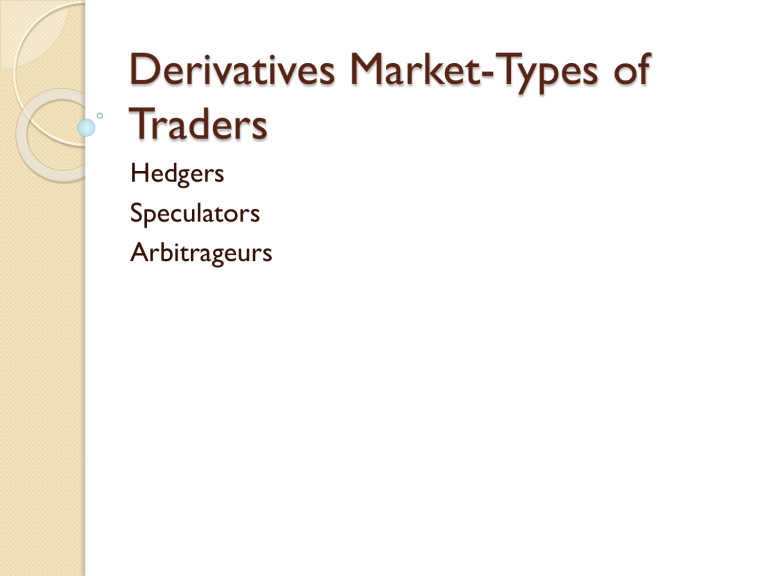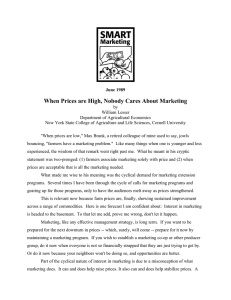
Derivatives Market-Types of Traders Hedgers Speculators Arbitrageurs Hedgers Hedgers use derivatives to reduce the risk that they face from potential future movements in a market variable or underlying asset Table Hedging Using forward Contracts Suppose that it is July 20, 2007, and lmportCo, a company based in the United States, knows that it will have to pay £10 million on October 20, 2007, for goods it has purchased from a British supplier. The USD-GBP exchange rate quotes made by a financial institution are shown in Table 1.1. ImportCo could hedge its foreign exchange risk by buying pounds (GBP) from the financial institution in the 3-month forward market at 2.0531. This would have the effect of fixing the price to be paid to the British exporter at $20,531,000. Hedging Using forward Contracts Consider next another US company, which we will refer to as ExportCo, that is exporting goods to the United Kingdom and, on July 20, 2007, knows that it will receive £30 million 3 months later. ExportCo can hedge its foreign exchange risk by selling £30 million in the 3-month forward market at an exchange rate of 2.0526. This would have the effect of locking in the US dollars to be realized for the sterling at $61,578,000 . Purpose of Hedging The purpose of hedging is to reduce risk. There is no guarantee that the outcome with hedging will be better than the outcome without hedging. A company might do better if it chooses not to hedge than if it chooses to hedge. Alternatively it might do worse. Purpose of Hedging Consider ImportCo. If the exchange rate is 1.9000 on October 20 and the company has not hedged, the £10 million that it has to pay will cost $19,000,000, which is less than $20,531 ,000. On the other hand, if the exchange rate is 2.1000, the £10 million will cost $21,000,000-and the company will wish that it had hedged! The position of ExportCo if it does not hedge is the reverse. If the exchange rate in October proves to be less than 2.0526, the company will wish that it had hedged; if the rate is greater than 2.0526, it will be pleased that it has not done so. Hedging Using Option Contracts Consider an investor who in May of a particular year owns 1,000 Microsoft shares. The share price is $28 per share. The investor is concerned about a possible share ,price decline in the next 2 months and wants protection. The investor could buy ten July put option contracts on Microsoft on the Chicago Board Options Exchange with a strike price of $27.50. Cost of Hedging with Options This will give the investor the right to sell a total of 1,000 shares for a price of $27.50. If the quoted option price is $1, then each option contract would cost 100 x $1 = $100 and the total cost of the hedging strategy would be 10 x $100 = $1,000. Benefit of Hedging with Options The strategy costs $1,000 but guarantees that the shares can be sold for at least $27.50 per share during the life of the option. If the market price of Microsoft falls below $27.50, the options will be exercised, so that $27,500 is realized for the entire holding. When the cost of the options is taken into account, the amount realized is $26,500. If the market price stays above $27.50, the options are not exercised and expire worthless. Graphical Representation Speculators Speculators use them to bet on the future direction of a market variable or underlying asset Speculation with forward Contracts Consider a US speculator who in February thinks that the British pound will strengthen relative to the US dollar over the next 2 month and is prepared to take the advantage from it with £250,000. One thing the speculator can do is to purchase £250,000 in 'the spot market in the hope that the sterling can be sold later at a higher price. Another possibility is to take a long position in four CME April futures contracts on sterling. (size of each futures contract is for the purchase of £62,500.) Speculation with forward Contracts Speculation with Option Contracts Options can also be used for speculation. Suppose that it is October and a speculator considers that a stock is likely to increase in value over the next 2 months. The stock price is currently $20, and a 2-month call option with a $22.50 strike price is currently selling for $1. The speculator is willing to invest $2,000. One alternative is to purchase 100 shares; the other involves the purchase of 2,000 call options (i.e., 20 call option contracts). Suppose that the speculator's hunch is correct and the price of the stock rises to $27 by December. Speculation with Option Contracts Comparison When a speculator uses futures, the potential loss as well as the potential gain is very large. When options are used, no matter how bad things get, the speculator's loss is limited to the amount paid for the options. Speculation with options


